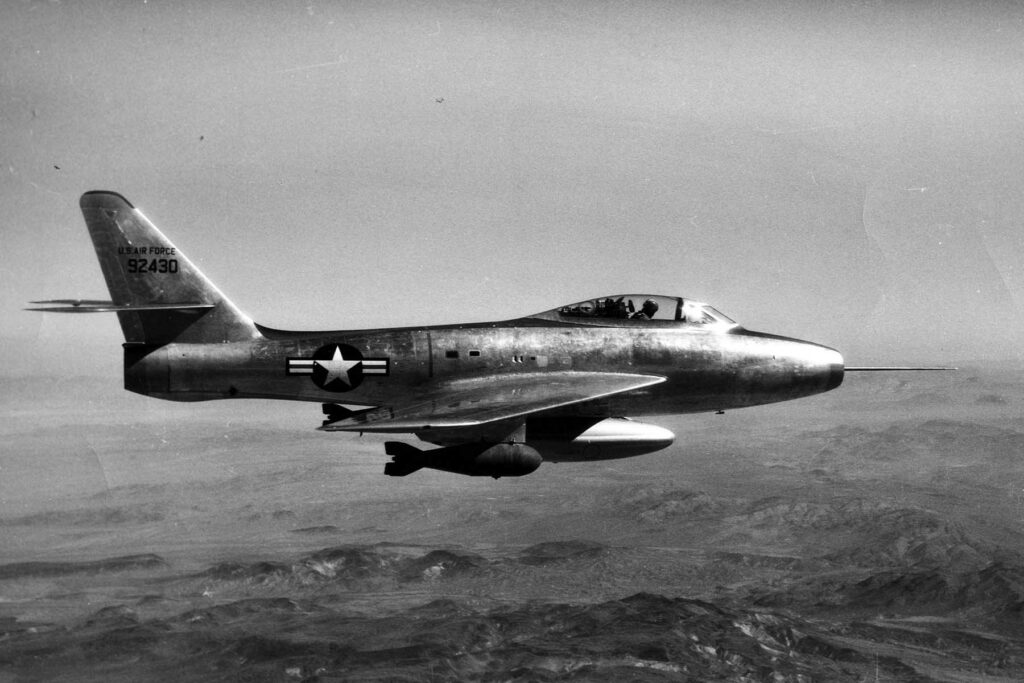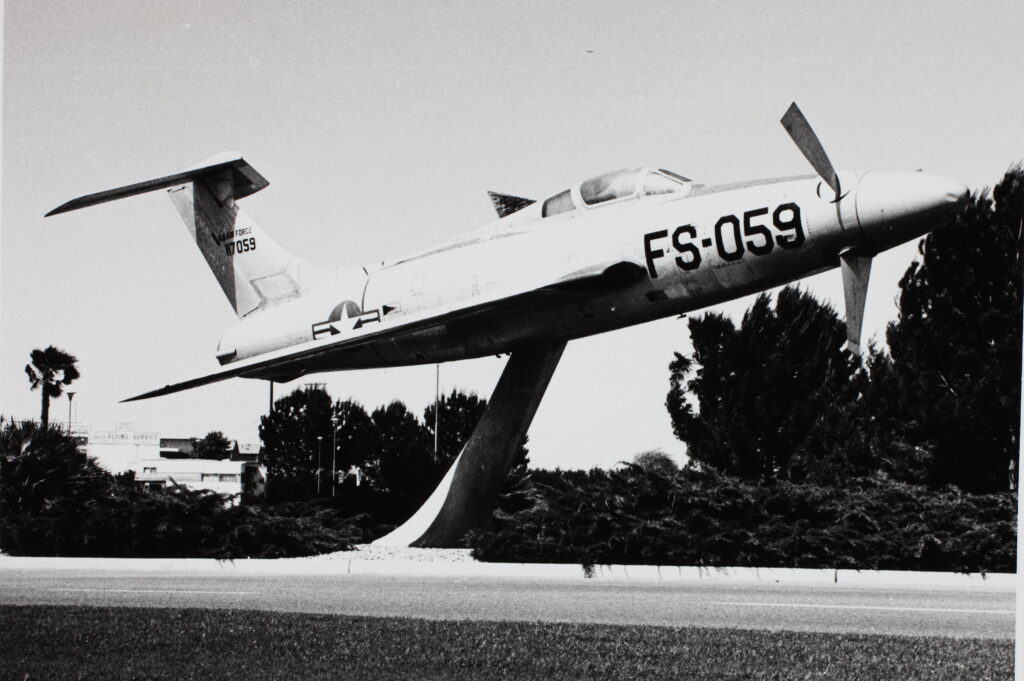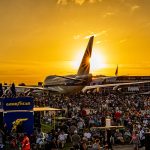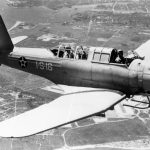It holds the title of “Loudest Aircraft in the World” because the sonic booms emanating from its propeller tips would make nearby ground crews sick and even sent one into seizures. The scream of an engine run-up could be heard 25 miles away and today marks the 69th anniversary of its first flight. It was the Republic XF-84H Thunderscreech.

The road to what was the ultimate development of the Republic F-84 series of aircraft, began in mid-1944 when Alexander Kartveli came up with the idea of a P-47 Thunderbolt powered by a General Electric J35 turbojet, but Republic shelved the idea and began work on an all-new design. The company received a formal contract for four Model AP-23 aircraft, which would be designated XP-84. The sleek fighter with pleasing lines first took to the skies over Muroc Army Airfield, California on February 28th, 1946. Over the next few years, Republic developed and built a number of derivatives of their new fighter, but not without a bit of confusion.

On May 29th, 1946, just three months after the first XP-84 flew, Republic was awarded a contract for a swept-wing fighter, but it was not the Thunderstreak, which was famously flown by the Thunderbirds for the 1955 season. Republic’s first swept-wing fighter was the inverse tapered wing XF-91 Thunderceptor, which first took the sky on May 9th, 1949. By that time, however, Republic had been working on Model AP-23M since mid-1948. To build that aircraft, the company pulled the last straight-wing F-84E, USAF #49-2430, off the line and fitted with flying surfaces that featured a 40-degree sweep back. This new jet received the Air Force designation YF-96A and first flew on June 3rd, 1950.

The YF-96A was powered by the Wright YJ65-W-1 turbojet, which required Republic to deepen the F-84 fuselage by 7 inches and make certain changes around the cockpit/canopy area. Then confusion ensued. In X-Fighters: USAF Experimental and Prototype Fighters, XP-59 to YF-23, Steve Pace wrote, “While the air force waited for Republic’s J65 powered model of the Thunderstreak to arrive, it was decided that the type’s many alterations were not enough to require a new designation. Thus, on September 18, 1950, in a move that really upset Republic, it redesignated the YF-96A, YF-84F. That action created an out-of-sync designation mess for Republic as it had already moved to designate the G version as the F version. But now the straight-winged G version would follow the swept-winged F version instead of vice versa.” To meet the USAF requirement for a high-speed reconnaissance aircraft, Republic developed the YF-84F Thunderstreak into the YRF-84F Thunderflash, which first flew on February 2nd, 1952.

Though the Thunderstreak was capable of over 600mph and for a time held the Los Angeles-New York speed record (3 hours 46 minutes, average 649 mph) the Air Force created Project MX-3347 to investigate the use of turboprop jet engines on fighter/interceptor aircraft. Republic offered the Thunderstreak in a detailed proposal, which the Air Force accepted and initially designated XF-106, but that was soon changed to XF-84H.
The two prototypes, USAF #51-17059 & 17060, were fitted with the 5,850hp Allison XT40-A-1 turboprop engine with a 12 ft diameter Aeroproducts propeller, consisting of three broad, square-tipped steel blades. With the XT40 taking up the space where the F-84F’s intake was located, the XF-84H featured the wing root intakes of the Thunderflash. Although it is not known when the XF-84H received its unofficial Thunderscreech name, it was likely coined before the jet even flew based on what crew chief Edward von Wolffersdorff told Smithsonian Magazine in 2003, “Oh man, that noise was terrible. I remember making my first ground runs with the thing, down on the main base, and I was wondering, ‘Why are they flashing that red light at me over in the control tower?’ It turned out they couldn’t hear a damn thing over their radios, so they kicked us out and sent us over to the north base.” However, that wasn’t far enough. After numerous complaints, Republic was directed to tow the Thunderscreech out to the far side of Rogers Dry Lake.
So, why was the Thunderscreech so loud? John M. Leonard of the Rolls Royce Heritage Trust performed extensive research on the aircraft and found that with the T40 turning at 14,300rpm through a 6.8:1 gearbox, the outer sections of the propeller blades were traveling at 1.18 Mach. This hammered anyone in plane with those blades with over one hundred sonic booms per second. The supersonic propeller tips were not the only culprit, however. The subsonic sections of the propeller blades and the T40’s turbine sections contributed to the aural assault as well. The wail of the aircraft ultimately required ground crewmen to communicate with signal flags and lights from a safer distance.
The most telling story of how debilitating the ‘Screech was on a human being was recalled by Republic test pilot Henry Beaird, “They tied it down on the taxiway [obviously this was prior to being banished out to the dry lake] next to what they assumed was an empty C-47, but that airplane’s crew chief was inside, sweeping it out. Well, they cranked that -84H up, made about a 30-minute run, and shut it down. As they were getting ready to tow it back to the ramp, they heard this banging in the back of the C-47. It was the crew chief knocked silly by the high-intensity noise and on his back on the floor of the -47, flailing his limbs.”

On July 22nd, 1955, Beaird took the first XF-84H aloft for its first flight, an event which was reported five days later in The New York Dispatch. It said, “The XF-84H, already test flown successfully, is described by the air force as ‘the fastest single-engine, propeller-driven plane ever built’.” The article also mentioned the so-called “vortex-gate”, the triangular-shaped blade mounted aft of the cockpit. This device was designed to counteract the torque of the XT40. While the XF-84H did demonstrate incredible acceleration, it was plagued with problems. The required 30-minute warm-up time for the Allison made it an impracticable combat aircraft and the propeller caused serious vibrations in the airframe and there were several mechanical failures in the prop pitch gearing.

Ultimately, the XF-84H #51-17059 and -17060 performed eight and four test flights, respectively, logging a combined total of just six hours and forty minutes of flight time. Beaird flew eleven of those flights with all but one ending with some type of in-flight emergency. The only other pilot to fly the Thunderscreech was Lin Hendrix, also from Republic, who noted, “…it never flew over 450 knots indicated, since at that speed, it developed an unhappy practice of ‘snaking’, apparently losing longitudinal stability”. As a matter of fact, so shaken by the flight that Hendrix flatly refused to fly it again. He reportedly told Jim Rust, Republic’s chief engineer who stood six-foot-four and weighed 235 pounds, “You aren’t big enough and there aren’t enough of you to get me in that thing again.”

In very short order both the XF-84H and XT40 programs were terminated. The second prototype, #51-17060 was scrapped, while #51-17059 became a gate guard for decades at Meadows Field, in Bakersfield, California. In 1992, it was taken to the Ohio Air National Guard’s 178th Fighter Wing and restored by volunteers and is now on display at the National Museum of the United States Air Force in Dayton, Ohio.

At the time of its first flight in 1955, the Air Force claimed that with a design speed of 670mph, the Thunderscreech would be the fastest single-engine propeller aircraft in the world. For years, The Guinness Book of World Records recorded this now-disputed “fact”. What is not disputed, however, is the Republic XF-84H Thunderscreech is, and likely always will be, the Loudest Aircraft in the World.
























